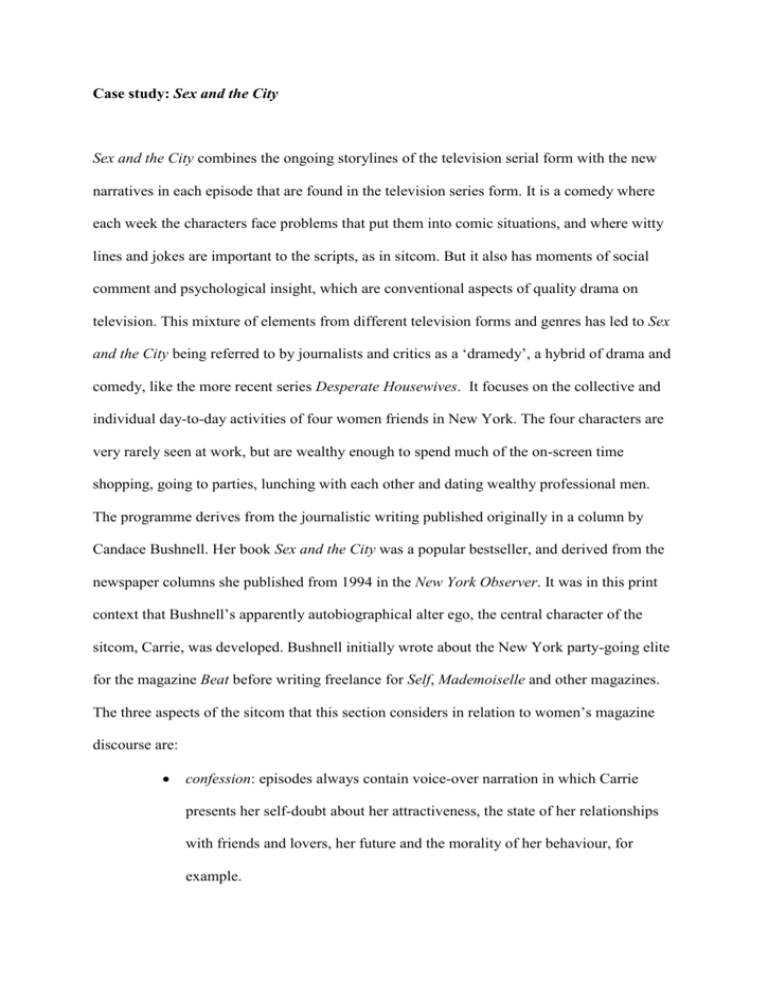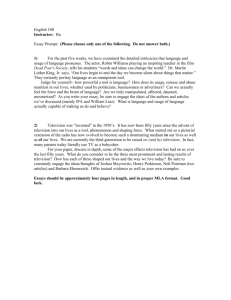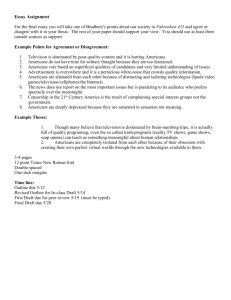Chapter Case Study
advertisement

Case study: Sex and the City Sex and the City combines the ongoing storylines of the television serial form with the new narratives in each episode that are found in the television series form. It is a comedy where each week the characters face problems that put them into comic situations, and where witty lines and jokes are important to the scripts, as in sitcom. But it also has moments of social comment and psychological insight, which are conventional aspects of quality drama on television. This mixture of elements from different television forms and genres has led to Sex and the City being referred to by journalists and critics as a ‘dramedy’, a hybrid of drama and comedy, like the more recent series Desperate Housewives. It focuses on the collective and individual day-to-day activities of four women friends in New York. The four characters are very rarely seen at work, but are wealthy enough to spend much of the on-screen time shopping, going to parties, lunching with each other and dating wealthy professional men. The programme derives from the journalistic writing published originally in a column by Candace Bushnell. Her book Sex and the City was a popular bestseller, and derived from the newspaper columns she published from 1994 in the New York Observer. It was in this print context that Bushnell’s apparently autobiographical alter ego, the central character of the sitcom, Carrie, was developed. Bushnell initially wrote about the New York party-going elite for the magazine Beat before writing freelance for Self, Mademoiselle and other magazines. The three aspects of the sitcom that this section considers in relation to women’s magazine discourse are: confession: episodes always contain voice-over narration in which Carrie presents her self-doubt about her attractiveness, the state of her relationships with friends and lovers, her future and the morality of her behaviour, for example. sexuality as the key to identity: happiness in sexual relationships, the prospect of sexual pleasure or worry over the unavailability of sex, and a sense that characters’ identities are expressed through their sexuality, are fundamental to the four women’s sense of themselves. commodity fetishism: this term (deriving from Marx’s analysis of capitalist societies) describes a fascination with consumer objects whose value lies in their power to signify as signs of luxury, social power, sexual attractiveness or some other valued meaning in the context of the ideology of Western societies. Examples of fetishised commodities in Sex and the City include designer shoes and clothes. The television sitcom draws on concerns with the components of feminine gender identity that are found in the discourse of women’s magazines, and feminist media critics writing about women’s magazines have argued that magazines such as Cosmopolitan and Marie Claire define the concerns of what Janice Winship (1987) calls a ‘women’s world’. This world is composed of representations that present a set of interests, problems and desires that may sometimes be incoherent and contradictory but nevertheless construct an identity for the feminine. In semiotic terms this world is a set of signs that define the signified meaning ‘feminine’ in distinction to the masculine: it is not a representation of the ‘natural’ reality of being a woman, but instead a structure of meanings that provide significance and social identity to women who buy into it. Magazines are themselves commodity products, whose costs of production are covered not simply by their purchase price but also by the advertisements for products presented to their readers. For Winship and other feminist critics magazines sell women a representation of femininity that shapes the social place of women. Ellen McCracken (1993: 3) argues that ‘women’s magazines exert a cultural leadership to shape consensus in which highly pleasurable codes work to naturalise social relations of power’. The pleasure of reading glossy women’s magazines, like the pleasure of watching Sex and the City, is the medium through which these ideological meanings of femininity are passed on. Magazines provide a location in which a sense of community and shared interest among women can be established, and where certain pleasures are attributed to feminine identity. These pleasures include: self-adornment (using cosmetics, adopting a personal style, being fashionable) self-improvement (how to have better sex, better hair, healthier food) sharing a collective identity (sharing in the same concerns and problems as other women). But as McCracken (1993: 136) argues, ‘within this discursive structure, to be beautiful, one must fear being non-beautiful; to be in fashion, one must fear being out of fashion; to be selfconfident, one must first feel insecure’. Feminists have argued that the pleasures offered by women’s magazines rest on the assumption that women’s lives offer relatively few pleasures, and that the aspirations addressed in them (to be beautiful, fashionable and confident, for example) show that women’s real lives deserve to be changed, rather than be made temporarily more tolerable by the short-term enjoyment of reading magazines. From this point of view, the emphases of Sex and the City episodes are on the wrong things, and perpetuate the agendas set by the women’s magazines that Winship, McCracken and others criticised. Carrie and her friends are almost never seen at work. The ability of Carrie and her friends to live lives of consumption, seeking happiness through relationships and exchanging gossip and insecurities, must depend on a relatively high level of income. The fact that they live in comfortable apartments in Manhattan indicates that they belong to a small and privileged group of young professionals who can live single, independent lives. From this perspective Sex and the City can be argued to render invisible the questions of economic status, work and social power for women. Furthermore, the central characters’ fascination with clothes, shoes, hair and personal style is a focus on relatively trivial aspects of women’s lives, in contrast to questions of gender equality and the difficulty that real women face in employment and opportunity. But perhaps most significantly for a feminist critique of gender representations in Sex and the City, the discourses of confession and selfdoubt that occupy so much of Carrie’s voice-over and the conversations among the group of friends perpetuate the assumption that feminine identity is a perpetual struggle with dissatisfaction about oneself. Feminine identity is represented in Sex and the City as something centred on lack and potential disappointment. The fact that the programme is a comedy is significant here, because, if it were not, the anxieties and struggles of the characters might have a more critical function. Comedy enables Sex and the City to engage with questions of feminine identity but also to dissipate them into physical comedy and verbal wit. Indeed, the sophisticated character comedy, the witty phrases, moments of insight and minor revelations that Carrie’s voice-over presents distance the viewer from the issues that are the subject of the narrative and instead focus attention on the television form in which they are communicated. Jokes, clever turns of phrase and comic reversals of fortune in Sex and the City focus the audience’s attention on Carrie and her friends’ ability to cope with emotional and social problems rather than their inability to analyse them critically and politically, or to change them. The Sex and the City television series draws on modes of confession that are also found in talk shows, in which individuals represent themselves by airing their problems and by bearing witness to the tribulations of other people. The programme establishes a ‘structure of feeling’ that is not unique to Sex and the City but that television audiences are already familiar with and in which they are invited to participate. What marks out Sex and the City from this context is its focus on a social elite, rather than the lower-middle-class participants in the majority of television confessional programmes. The television series features millionaires, wealthy men who date models and the fine art scene, and is peopled by characters who are rich, attractive and well connected. So while Sex and the City uses television forms that are already significant in talk shows, where the audience is invited to identify with ‘problems’ and share in discussion of how to improve the lot of participants and themselves, the sitcom transfers these worries about the self and how to live to an elite social group, and places them in the context of comic fictional narrative. The significance of the transfer of the confessional discourse from women’s magazines and talk shows into this class and status group is that it enables the programme to address a valuable television audience sector. Taking a critical Television Studies position in relation to this programme, Sex and the City can be regarded as a commodity in which a gendered discourse of confession and witness becomes commodified itself, as a means of addressing a particular class and gender group in the television audience. Its creator Candace Bushnell has been quoted in magazine interviews as saying that she regards the programme as concerned less with gender than with the dynamics of wealth and power. She meant that, in her view, Sex and the City is about people’s relationships that have more to do with their social position and status in relation to each other than with whether an individual is male or female. In one sense this is accurate, since, for the production company and its parent company, Sex and the City is primarily important as a vehicle to address a specific audience and thus to generate revenue and profit, whether that audience is male or female, and whether the representations of characters in the programme are socially and politically progressive or not. An analytical approach to the sitcom, however, would be concerned not only with this economic context but also with the detail of how representations of gender and sexuality are constructed in the programme, and how audiences might understand them. From a point of view that is interested in the representation of femininity and the political impact of those representations, Sex and the City can be argued to perpetuate discourses about women’s self-absorption, the focus on heterosexual sex as the barometer of personal and social success, and the normalisation of commodity fetishism as the environment in which women exist ‘by nature’. For more than forty years feminist critics have been reacting against these kinds of representation, and aiming to liberate women from their oppressive restrictions on what being female and feminine mean. Comedy drama continues to focus on many of these representations of femininity, for example in the US series Desperate Housewives, which at first glance seems to be a series that focuses much more on women than men, and seems to focus on the women’s independence and activity. However, it could be argued that the central women in Desperate Housewives are for various reasons disempowered and severely restricted in their scope for independent action. In its first episode Mary Alice Young commits suicide despite apparently having a perfect house and family in a wealthy suburb. In subsequent episodes her narration introduced her family, friends and neighbours as they gradually delved under this perfect surface to reveal her involvement in murder and conspiracy. In the first series, these female neighbours comprised Susan Mayer, a divorced single parent with her own career but who is driven by her need to complete herself by finding a satisfying relationship with a man, and Lynette Scavo who is frustrated by the task of juggling the roles of wife, mother and successful office worker. In addition, Bree Van De Kamp’s alcoholism and poor relationships with her children belie her surface appearance as the ideal housewife, Gabrielle Solis’ material possessions and glamorous appearance contrast with her ongoing competitiveness and jealousy towards her husband, and Edie Britt schemes to undermine her supposed friend Susan, especially by using her overt sexuality as a weapon. Far from being a community of women friends (as the characters of Sex and the City are), the women of Desperate Housewives are indeed ‘desperate’; on one level the series offers resources for a devastating critique of the ideals that real women might have, and the distance between the images of success that representations such as women’s magazines display and the complexities of actual experience. But within the codes of television comedy drama, these problems are quickly raised as obstacles to generate storylines and dramatic moments and then passed over as the next twist in the story appears. As in Sex and the City, the comic aspects of Desperate Housewives work to displace the action from relevance to these ideological issues, and instead to focus the action onto characterisation and skilled performance by the actors, and on the creation of cliffhangers that ask the audience to speculate about what resolution or disaster will happen next.








